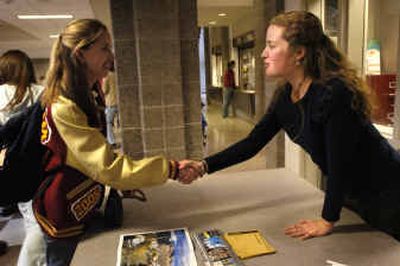College slots get tougher to come by

This may keep some high school seniors awake at night.
In the competition to get into college, there are seniors who have already been accepted – by more than one school.
Erika Schlieder, 17, a senior at University High School in Spokane Valley, has been accepted by two out-of-state colleges, the University of Montana and the University of Idaho.
Schlieder and her classmates are facing one of the most competitive environments to get into colleges in years. Washington’s state universities have seen rapidly rising enrollments and stagnant funding, and students are being forced to get on the ball or be left behind.
“I just want to be ahead,” said Schlieder, an honors student.
On Thursday, Schlieder stopped by a table in the bustling University High School lunchroom where the University of Montana recruiter set up a display of brochures. Since October, several recruiters have scheduled visits at the school to attract students.
Schlieder said she preferred out-of-state programs to the local schools. That may come as a relief to college hopefuls targeting Washington’s public universities.
Washington’s state colleges last spring saw a glut of applications, especially at very competitive schools like the University of Washington. So far, this year looks to be a repeat, with almost 62,000 seniors expected to graduate from high school. On average, 61 percent of high-school graduates (in this case almost 38,000 students) move on to some form of college. The state’s public four-year colleges and branch campuses enrolled 102,000 students in 2002. Independent colleges enroll about 42,000 students and public community and technical colleges enroll about 260,000 students.
In the spring, there was hope among educators that Initiative 884 would pass and raise $400 million a year for higher education with a one-cent sales tax hike, but it was defeated by voters this week. The initiative would have also raised $600 million annually for K-12 schools.
The Higher Education Coordinating Board has asked for more funding to meet increased demand. The Office of Superintendent for Public Instruction also plans to ask the Legislature for more money. All education eyes will be on the cash-strapped Legislature.
Meanwhile, high school seniors, high school counselors and college admission officers are planning as best they can.
“I’ve had more kids this year do early decision than I’ve had in the past,” said Pat Shelly, counselor at University High School. Students who make early-decision deadlines have a better chance of getting into college because the longer students wait, the fewer slots are available.
Shelly’s also seen a greater number of students meet with visiting college recruiters. All this suggests that either parents or students understand that getting into college isn’t easy anymore.
Another sign of the increased competition is a recent change in a crucial admission deadline at WSU.
Two years ago, the early deadline was May 1 at WSU. Last year it moved up to March 1. This school year the deadline is Jan. 31. That’s getting close to the UW’s Jan. 15 deadline, the earliest public college deadline in Washington.
WSU has been accepting applications for fall 2005 since September. Students can make later deadlines, but the competition gets tougher later in the year.
“Students are best advised to get their applications in early,” said Wendy Peterson, director of admissions at WSU. “We’re expecting it will get more and more competitive each year.”
WSU has about 10 recruiters who are scattered around the region at high schools and job fairs. Recruiters at University High School have seen busier schedules, said Shelly.
“In the past, I’ve seen where the college reps would come in and no one would come,” Shelly said.
Madeline Mussman, admissions counselor for the University of Montana, has spent the past several days touring both public and private schools, from Gonzaga Prep to Ferris High School and Kellogg High School in Idaho.
Washington sends a significant number of students to the university in Missoula, Mussman said.
“Depending on where we’ve gotten students, that’s where I go,” she said.
Mussman’s also attending the free National College Fair at the Spokane Center on Monday from 9 a.m. to 1 p.m. and 6 to 8 p.m. The event pulls recruiters from 30 states nationally.
Rogers High School counselor Joe Busch is bringing three buses of students.
“If my students want to leave Spokane, if they want to leave Hillyard, I want to get them a ticket,” Busch said.
About 10 percent of Rogers students go on to college, Busch said. He said many students come from families that hadn’t attended college. He tries to give them a nudge, and explains how financial aid can make college possible.
“I try to debunk that they’re a poor kid at Hillyard who can’t afford college,” Busch said.
Cheryl Stitt, a Medical Lake High School counselor, said more students are looking to state schools because they feel like they can no longer afford private schools.
“We have some valedictorians and salutatorians who are attending community colleges,” Stitt said. “It just seems like lately our kids are really leaning toward the practical side of things.”